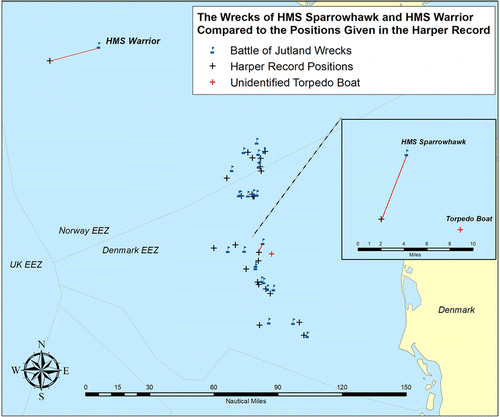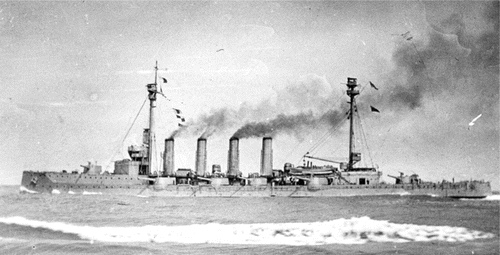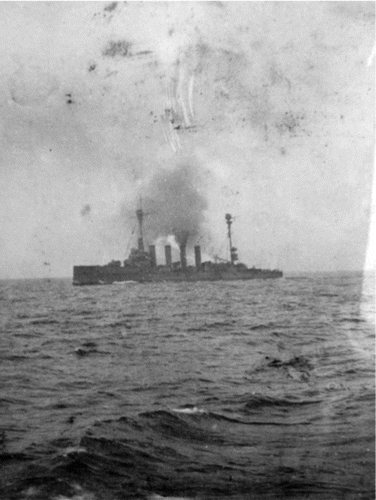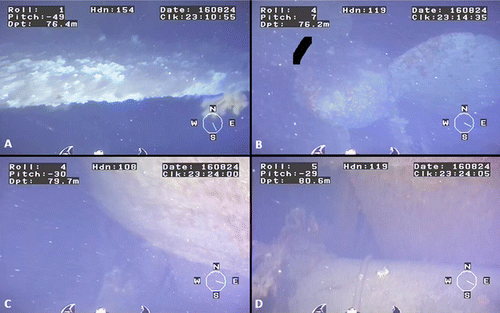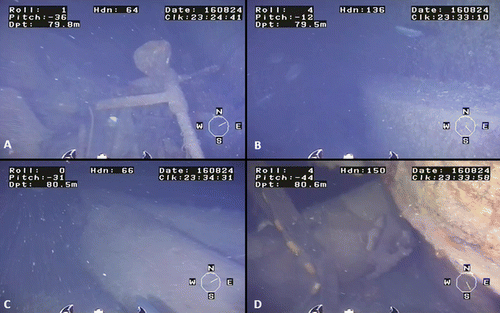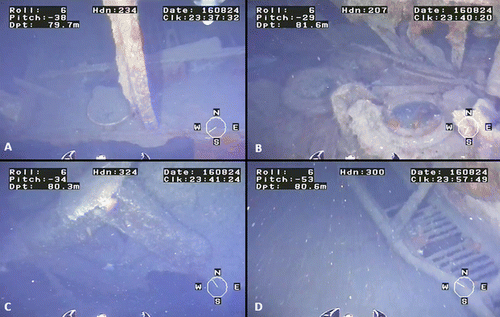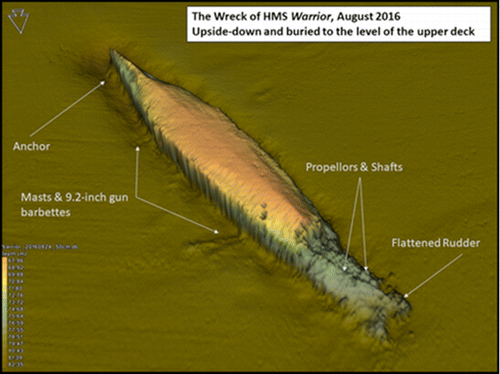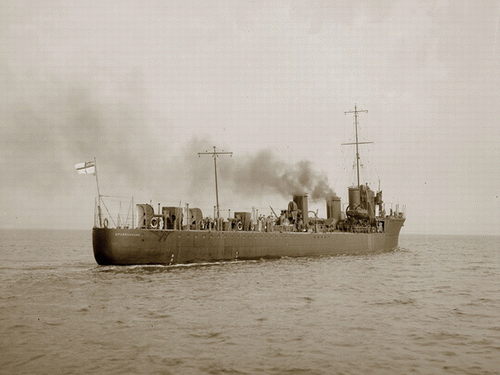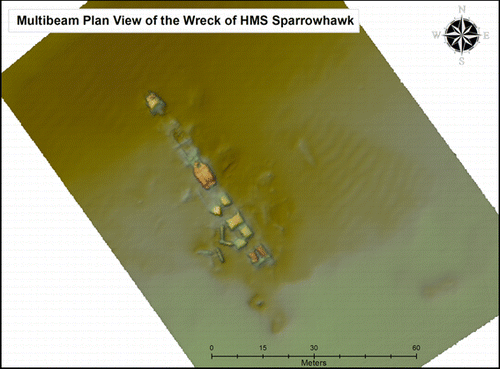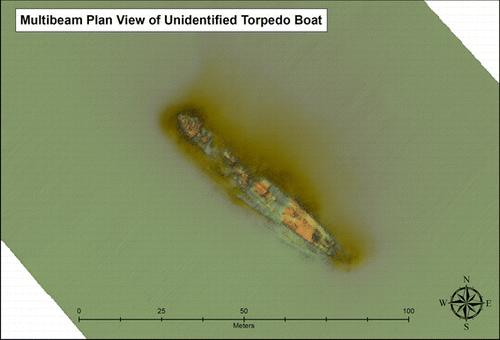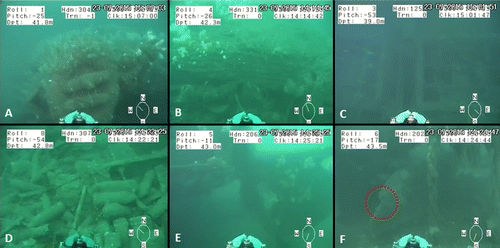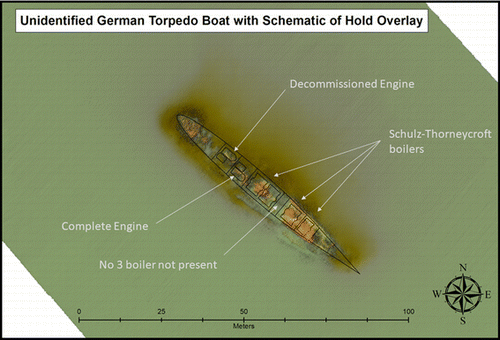Abstract
Due to the circumstances of the loss of HMS Warrior and HMS Sparrowhawk in 1916, in which subsequent to disablement both had drifted and been towed unknown distances from the Jutland battlefield, they were not located in the 2015 Jutland survey. In August 2016 both ships were located and HMS Warrior was revealed to be a pristine warship wreck, the only example in this condition of the 25 ships sunk in the battle. HMS Sparrowhawk had a similar pattern of disturbance as seven of the other Battle of Jutland destroyer wrecks. The survey of these wrecks draws to a conclusion a long period of discovery at Jutland and raises questions as to how these important cultural artefacts should be treated in the future.
Abstracto
Hundimiento en la mañana: los descubrimientos y prospecciones del HMS Warrior y el HMS Sparrowhawk, los últimos naufragios faltantes de la Batalla de Jutlandia
Dadas las circunstancias de la pérdida del HMS Warrior y el HMS Sparrowhawk en 1916, en que, tras ser deshabilitados, ambos quedaron a la deriva y fueron arrastrados distancias desconocidas del campo de batalla de Jutlandia; estos no fueron localizados en la prospección de Jutlandia de 2015. En agosto de 2016 ambos barcos fueron hallados y se reveló que el HMS Warrior es una nave de guerra en condiciones prístinas. De los 25 barcos hundidos en la batalla, este es el único ejemplar en estas condiciones. El HMS Sparrowhawk tiene un patrón de disturbación similar al de otros siete naufragios de destructores hundidos durante la Batalla de Jutlandia. La prospección de estos naufragios llevó a la conclusión de un prolongado periodo de descubrimientos en Jutlandia y dio lugar a preguntas tales como en qué forma deben ser tratados estos importantes artefactos culturales en el futuro.
Palabras clave: arqueología náutica, arqueología de campos de batalla, arqueología del conflicto, Batalla de Jutlandia, Primera Guerra Mundial, Royal Navy (Armada Británica).
摘要
沉于黎明: 日德兰海战最后失踪的皇家勇士号 (HMS Warrior) 与雀鹰号 (HMS Sparrowhawk) 的发现与调查
由于皇家勇士号 (HMS Warrior) 与雀鹰号 (HMS Sparrowhawk) 在1916年沉没前都在失去动力的情况下漂离并被拖引出日德兰海战战场, 其距战场的具体距离不得而知, 因而2015年的日德兰海战调查并没能确定它们的下落。在2016年9月, 这-艘沉船均被找到, 并且皇家勇士号的船体未经扰动, 这是25艘日德兰海战沉船中的唯一-例。而皇家雀鹰号则与其他七艘驱-舰残骸的保存状况相类似。针对这些沉船的调查不仅为这-长期的日德兰海战发现之旅画上了句号, 并提出诸如如何在未来处理这些-要的文化产物等问题。
关键词: 航海考古学, 战场考古学, 冲突考古学, 日德兰海战, 第一次世界大战, 皇家海军
沉于黎明: 日德蘭海戰最後失蹤的皇家勇士號 (HMS Warrior) 與雀-號 (HMS Sparrowhawk) 的發現與調查
由于皇家勇士號 (HMS Warrior) 與雀-號 (HMS Sparrowhawk) 在1916年沉沒前都在失去動力的情況下漂離-被拖引出日德蘭海戰戰場, 其距戰場的具體距-不得而知, 因而2015年的日德蘭海戰調查並沒能確定它們的下落。在2016年9月, 這兩艘沉船均被找到, 並且皇家勇士號的船體未經擾動, 這是25艘日德蘭海戰沈船中的唯一-例。而皇家雀-號則與其他七艘驅-艦殘骸的保存狀況相類似。針對這些沉船的調查不僅爲這-長期的日德蘭海戰發現之旅畫上了句號, 並提出諸如如何在未來處理這些-要的文化産物等問題。
關-詞: 航海考古學, 戰場考古學, 衝突考古學, 日德蘭海戰, 第一次世界大戰, 皇家海軍
ملخص

The Battle of Jutland, fought 31 May to 1 June 1916, saw the two most powerful battle fleets in the world clash off western Denmark. More skirmish than battlefleet action, the German High Seas Fleet, having unintentionally encountered the entire British Grand Fleet, slipped into the mists of the North Sea and escaped. But in the 16 hours in which this drama unfolded, 25 ships were sunk and 8500 lost their lives. The Grand Fleet lost 14 of the ships and around 6000 of the sailors killed. Two of the 14 losses are the subject of this article.
In April 2015 the author partnered with the Danish Sea War Museum Jutland to locate and survey with swath bathymetry and ROV the shipwrecks sunk in the Battle of Jutland 1916. Of the 25 ships sunk, 22 were located and surveyed (McCartney, Citation2016). In 2016 two further expeditions into the North Sea followed, which were in part aimed at finding the last three missing shipwrecks. In March 2016, SMS V4 was found along with the stern portion of HMS Indefatigable (McCartney, Citation2017a). Finally, in August 2016, the survey pinpointed the locations of HMS Warrior and HMS Sparrowhawk.
The losses of both of these last two ships share common features in that they occurred not in battle, but in the hours afterwards as their battle‐damaged remains finally succumbed to the sea, with the survivors being rescued by passing allied warships returning to Britain. It was known that both vessels were disabled in battle, drifted without power, and were then towed an unknown distance before being scuttled (Harper, Citation1927). This meant that they would probably be the most time‐consuming to locate because it was thought that they would lie outside of the main battlefield area. With the mission of surveying as many of the Jutland shipwrecks as possible in the time allowed in 2015 they had consequently been of low priority. However, the results of the 2015 survey once analysed revealed that the chronology of the Battle of Jutland produced by the Royal Navy's navigation school in 1919, known as the Harper Record (Harper, Citation1927), represented a very accurate spatial depiction of the battle (McCartney, Citation2016: 243–247). This was encouraging because it gave positions for the losses of both the missing ships, giving us a good starting position for both searches.
As it turned out, the position given for HMS Warrior's loss was the most inaccurate in the entire Harper Record by a very considerable margin. The wreck lies 25 miles from the Harper position. Comparison of the Jutland wreck‐sites with Harper's estimated positions showed the average discrepancy to be 3.5 nautical miles (McCartney, Citation2016: 244). Sparrowhawk lies six miles from the Harper position (Fig. 1). As described here, an additional destroyer wreck was located to the east of Harper's position for Sparrowhawk. This also had to be eliminated as a candidate for Sparrowhawk during the survey work.
HMS Warrior
The armoured cruiser HMS Warrior was the named ship of its class of four, Warrior, Achilles, Cochrane, and Natal. They were the penultimate class of armoured cruisers built by Britain but by the time of the Battle of Jutland, little more than 10 years after HMS Warrior was launched, it was an obsolete ship. The primary reason for this was the development of the dreadnought version of the armoured cruiser; the first battlecruiser, HMS Invincible, was launched in 1907, just two years after Warrior, and was also lost at Jutland.
The Warrior class displaced 13,767 tonnes, was 154m long and 22m wide (Fig. 2). Their main armament was made up of guns mounted in single turrets, 6 × 9.2‐inch and 4 × 7.5‐inch. The 9.2‐inch guns were mounted forward and aft and in the pairs of turrets mounted nearest to the foremast and mainmast. These turrets slightly overhung the line of the upper deck, a feature that helped in confirming the ship's identity.
The 7.5‐inch turrets were mounted two a side in the centre of the ship. HMS Warrior represented the apogee of the armoured cruiser concept, particularly in the arrangement of all of the main guns on the upper deck enabling them to be fired in any sea state. The ships of this class were renowned for being excellent sea boats and stable gun platforms, leading to them being regarded as the best cruisers Britain had ever built (Parkes, Citation1966: 441–447).
The sinking of HMS Warrior
Although past their prime, armoured cruisers were employed in two squadrons by the Grand Fleet in a scouting role during the Battle of Jutland. This role was originally planned to have been carried out by the battlecruisers, but they had been formed into a separate unit, the Battle Cruiser Fleet operating independently out of Rosyth. So the old armoured cruisers were used to fulfil the battlecruiser's role (McCartney, Citation2016: 89).
The all‐armoured First Cruiser Squadron (1CS) was made up of HMS Defence (Rear Admiral Sir Robert Arbuthnot commanding), HMS Warrior, HMS Duke of Edinburgh, and HMS Black Prince. Only Duke of Edinburgh survived the battle. During the outset of the brief fleet action at the height of the battle, the 1CS came fatally close to the German battle line. It seems that Arbuthnot attempted to finish off the damaged German light cruiser SMS Wiesbaden. In doing so, 1CS passed into the space between the two battle fleets and unwittingly became a target for the van of the German Fleet, receiving damage it was never designed to withstand. HMS Defence was peremptorily sunk with all hands (McCartney, Citation2012: 56–58).
At the time of Defence's loss, only Warrior was directly in line astern, as the other two ships had been sailing as detached wings of the battle fleet. It seems at least Duke of Edinburgh was attempting to rejoin the line at this time and Black Prince was further behind. Under fire initially from the German battlecruisers at the head of the German fleet and then by the van of the battlefleet itself, Defence exploded at around 18:19. By this time, Warrior had already been fatally damaged and turned away north‐west to seek relief behind the British line (Harper, Citation1927: 38).
According to the reports filed by Warrior's commanding officer, Capt. V.B. Molteno, as soon as Warrior turned away it was noticed that the ship was rapidly losing speed. Within ten minutes news was received on the bridge that both engine rooms were disabled. But as they filled with seawater, the ship's propellers kept revolving and took Warrior out of danger. Turning for base, the small seaplane carrier HMS Engadine was spotted and signalled to stand by. A photograph shows HMS Warrior as seen from Engadine at this time (Fig. 3).
By 20:00 it was clear that seawater was almost filling both engine rooms and that Warrior would soon come to a stop, so was taken in tow by Engadine. Towing continued all night, but by 07:45 it was clear that despite heroic efforts, Warrior was going to sink and had to be evacuated. The crew was transferred to Engadine and Warrior was abandoned. In the hope that the ship might later be towed by a larger vessel in calmer seas, all water‐tight doors were shut and the ship was left adrift (Admiralty, Citation1920: 289–295). Capt. Molteno's post action report lists 67 crew killed and one missing. They went down with the ship (Citation17TNA ADM 137/302).
Discovery and survey
That Warrior had been cast adrift meant that any calculation as to where it actually sank could only be roughly estimated. So despite the fact that both Warrior and Engadine fixed the position where the ship was abandoned, it was not likely that it would be found nearby. The weather at the time of abandonment is known to have been blowing from the south‐west at around force 5–6 (Meteorological Office, Citation1916: 153 and Citation17TNA ADM 137/302: 398). So it seemed that the wreck may possibly be found further east than the abandonment point. This proved to be the case.
After several other wrecks had been surveyed and ruled out, the wreck of HMS Warrior was located in the late evening of 24 August 2016 at a position recorded in Danish records held by Sea War Museum Jutland as a net snag (Fig. 4). The wreck points to the south‐east and was measured at the correct length and width for HMS Warrior. On the digital terrain model (DTM) it looked as if the wreck was completely upside‐down and therefore few of the readily identifiable features could be seen. Inspection by ROV was required to ascertain for certain that the wreck was HMS Warrior, but also to attempt to discern the manner of its sinking. The ROV was deployed at 23:00 and aside from the ROV's lighting the wreck was in complete darkness throughout the inspection, explaining the dark character of the images.
The ROV passed from the northerly end of the wreck down the north side and around the bow. In the stern area the rudder was seen to have been flattened into a near horizontal position (Fig. 5A). Both propellers were present and one is visible in Figure 5B. Both propeller shafts and the rudder were observed to have been bent so that they lay with a bias to the starboard side of the wreck. The ROV then moved to the level of the upper deck and the curved overhanging structure of the after starboard side 9.2‐inch gun barbette could be seen (Fig. 5C). The turret itself is mainly buried and there is no clearance under the wreck. The armoured wall of this turret was seen to have split along a join in the armoured plate (Fig. 5D), probably because it is one of the structures supporting the entire weight of the ship. In the foreground of Figure 5D is a section of the mainmast, which was observed to be running out from under the body of the wreck at this point.
The ROV continued along the starboard side of the ship at the seabed level (Fig. 6). The remains of a pinnace with its distinctive propeller was seen just forward of the visible portion of the mainmast (Fig. 6A). The underside of the overhanging barbette (now inverted) of the forward of the 9.2‐inch gun turret on that side of the ship was visible (Fig. 6B). Under it, a portion of the foremast could be seen poking out (Fig. 6C). This has folded back on itself and the top is buried under the wreck. The foremast passes out from under the wreck just forward of the turret (Fig. 6D). It must have fallen over the gun barrel as the ship sunk.
The bow area of the wreck was observed to be the most degraded (Fig. 7). The exposed frames at the forward end of the ship, approximately in line with ‘A’ turret, were recorded (Fig. 7A) beyond the forward end of the armoured citadel, at a point where at the upper‐deck level no armour was fitted (Parkes, Citation1966: 443). Here, the thinner metal of the hull has entirely corroded, leaving a porthole to lie on the underside of the upper deck. Further forward, more portholes could be seen lying on the seabed and the frames themselves have buckled (Fig. 7B). The probable reason for this is visible in Figure 7C, as it is the sheer weight of the anchor, its hawse, and cables that is forcing this area downwards. The distinctive outer walkway of these armoured cruisers was also seen (Fig. 7D). The area shown is on the port side of the wreck, in line with ‘A’ turret.
Concluding remarks
The wreck lies at a general depth of 80m but the scouring around it goes down to beyond 82m (Fig. 8). The wreck is almost entirely upside‐down. Its SE/NW orientation is consistent with a vessel that had drifted beam on to the prevailing weather as reported at the time. The noticeable holes in the DTM in line with the engine room were not examined by ROV. They may well turn out to be the exit holes of the rounds which sunk the ship. This cannot be known for certain until the wreck is examined again in the future.
The survey of the wreck shows that it must have sunk stern first. It was last seen heavily down by the stern. It seems probable that the stern may have temporarily embedded itself in the seabed when the ship hit bottom. Being nearly twice as long as the sea is deep its bows would have risen into the air and the weight of the upper works would have twisted it upside‐down as it descended to the bottom. It must have been inverted when it settled to account for the masts being crushed underneath it, as they are. This also explains how the rudder was twisted through 90 degrees and the propeller shafts were bent.
A very surprising feature is the distance the wreck was found from the Harper position (as described earlier). Moreover, the position given by Harper for where the ship sank is not the same as that reported by Capt. Molteno (Admiralty, Citation1920: 293). In fact, Molteno gave two different positions. The first was the point recorded for the abandonment as agreed by both Warrior and Engadine. This was subsequently amended to 15 miles further north (magnetic) (Admiralty, Citation1920: 293), which by the variation in the area in 1916 is 13.25 degrees west of due North (Gordon, Citation1996: 605). Interestingly, both of these positions plot an implausibly long 60 nautical miles west of the wreck. Clearly something isn't quite right.
Harper may have noticed in 1919 that some element of Molteno's reckoning was odd. Because when the Harper Record was completed, the sinking position given is closer to where Warrior actually lies, but still over 25 miles from the wreck (Harper, Citation1927: 110). He would have known from the reports from Warrior and Engadine that the slowly settling ship was heavily down by the stern with decks awash and was considered likely to survive less than three hours (Admiralty, Citation1920: 293 and Citation17TNA ADM 137/302: 398). Under such conditions he must have concluded that Warrior would not have drifted far before foundering. So why did he move the Molteno position further east by 35 miles?
The answer may lie in the fact that the speed Engadine measured while towing Warrior seems too fast. Initially it was measured at 8.2 knots, then by morning at 6 knots (Admiralty, Citation1920: 292). It seems this may have been overly optimistic. Certainly a slower progress under tow would bring the Molteno position nearer to the wreck‐site. But it also opens the possibility that Warrior may have drifted unmanned for several more hours than previously thought.
Another cruiser, albeit significantly smaller, was lost on 1 June 1916 while immobile and drifting. SMS Wiesbaden—coincidentally the ship Warrior was trying to dispatch when it was fatally holed—is known to have drifted for several hours at a speed of one knot (McCartney, Citation2016: 132–133). A similar rate of progress for HMS Warrior would mean that it may have stayed afloat for more than 24 hours. However implausible this may be, it cannot be ruled out from the evidence that now survives. But in reality a combination of factors including a slower towing speed, navigational inaccuracy, and a drifting ship all conspired to create the positional discrepancy we see today.
HMS Sparrowhawk
HMS Sparrowhawk was an Acasta‐class destroyer built to Admiralty design by Swan‐Hunter in 1912. It was the identical sister ship to HMS Shark which was also sunk during the Battle of Jutland. The Acasta‐class displaced 1090 tonnes and was 81.5m long and 8.2m wide. The sleek design of British destroyers—the Germans referred to comparable vessels in the High Seas Fleet as torpedo boats—is shown in Figure 9. The 20‐ship class of Acastas were the first British destroyers to be fitted with all 4‐inch gun main armament, with three guns of this type fitted and a pair of torpedo tubes. They were capable of at least 29 knots, powered by twin shafts and turbines, and four Yarrow‐type boilers (March, Citation1966: 124–132).
At the time of the Battle of Jutland, HMS Sparrowhawk was part of the Fourth Flotilla, based at Scapa Flow. It was made up of destroyers and two large destroyer leaders, HMS Broke (later of the Battle of the Dover Straits fame) and HMS Tipperary. More than a quarter of this flotilla was sunk at Jutland.
The sinking of HMS Sparrowhawk
By 23:00 on 31 May, the Fourth Flotilla was screening the starboard wing at the rear of the British battlefleet as it progressed southwards, looking to regain action with the German fleet at first light. At this time the German line, which had been to the west, crossed eastwards behind the largely unaware British, but in doing so it ran into the Fourth Flotilla (McCartney, Citation2016: 217). The subsequent series of night actions saw several British destroyers sunk in the darkness (McCartney, Citation2016: 216–237). A summary of Sparrowhawk's loss is given here.
It was during these confused actions that HMS Sparrowhawk found itself rammed twice by members of its own flotilla, ultimately succumbing to the damage sustained. At around 23:25 the flotilla leader, HMS Broke, just ahead of HMS Sparrowhawk, sighted the vague silhouette of a line of ships ahead and made the British recognition signal. The reply came in the form of the dazzling searchlights of the German fleet and a hail of fire. The British returned fire and a torpedo hit the light cruiser SMS Rostock at this time.
But as the line of British destroyers turned away, HMS Broke was hit in the bridge by a shell, jamming the helm. The ship turned full circle and slammed into the side of HMS Sparrowhawk, just abaft the bridge. The two ships became locked together and rapidly slowed. The onrushing destroyers behind tried to avoid colliding with the two conjoined warships, but HMS Contest ran into Sparrowhawk's stern, slicing off several feet of it, jamming the rudder, and opening the tiller flat to the sea. HMS Broke was able to get free and limped northwards out of the battle, heading for Britain, but Sparrowhawk damaged fore and aft, was now adrift and only able to turn in circles.
A narrative by survivors of Sparrowhawk’s ordeal at night was published in 1921 (Fawcett and Hooper, Citation1921: 347–357). Aboard the drifting ship, in the distance the hapless remains of the burning HMS Tipperary could be seen, until it sank at around 02:00. Things looked bad for Sparrowhawk as the streaks of dawn illuminated the sky. At that time a German light cruiser emerged from the mist, but then sank much to the relief of Sparrowhawk's survivors. This was the light cruiser SMS Elbing, which had collided with its own line during the same action. At around 06:00 a raft of survivors from Tipperary was picked up and just afterwards the entire forward section of the ship ahead of where it had been rammed by HMS Broke fell off, taking the two ship's dogs, which were trapped within, to the bottom.
Rescue came sometime thereafter when the destroyer HMS Marksman, returning home, took Sparrowhawk in tow, but ultimately had to recover the crew and sink the ship as the tow had parted in the rising seas and the fatally wrecked destroyer could not be safely brought back across the North Sea. Considering what the ship had been through, it is perhaps surprising that only six had died.
Prior to the 2015 survey the author carried out archival research to attempt to establish the possible areas in which the missing wrecks of Jutland were located. The details of Sparrowhawk's movements subsequent to being disabled were difficult to discern. No after action report by HMS Marksman could be traced and it seemed one was not filed after the battle. Other sources conflict in a number of crucial details. For instance Sparrowhawk's commanding officer's post action report states that Marksman had come to his aid around 04:00 (Admiralty, Citation1920: 321 and TNA 137/302) but the account given in the 1921 narrative says it was actually 07:15 (Fawcett and Hooper, Citation1921: 356). HMS Marksman's log seems to support the latter and stated Sparrowhawk was sunk at 09:10, but no position is given (Citation15TNA ADM 53/48439).
Ultimately the circumstances of the loss of this ship were such that it was considered difficult to justify spending valuable survey time looking for it. This was primarily because we would be looking for two halves of the ship, separated by an unknown distance. Moreover, it could not be satisfactorily ascertained how far Sparrowhawk may have drifted and in what direction. At that time the overall accuracy of the Harper Record had not been tested and its positional details were not considered reliable.
Discovery and survey
In the weeks after the 2015 survey, the site of a potential torpedo boat or destroyer was identified in the survey dataset. This site, Site A, subsequently identified as HMS Sparrowhawk, was briefly inspected by a team from the Sea War Museum Jutland using an ROV in July 2015. It looked to be a promising target but, to confuse matters, another site, Site B, had been found that also looked like a similar type of vessel. Both unidentified wrecks were within a ten mile radius of the Harper Record's position for Sparrowhawk's loss (Harper, Citation1927: 110). Moreover, both site's multibeam scans showed the types of dimensions we had come to associate with the German and British destroyer types in service during the WW1 period. During the 2016 surveys of March and August both of these sites were reinvestigated and HMS Sparrowhawk was finally identified (Fig. 1).
The DTMs of the two wrecks examined in 2016 showed wrecks that are dimensionally consistent with WW1‐era destroyers. Site A looked dispersed in a similar way to that seen on several other Jutland destroyer sites (Fig. 10). The wreck at Site B appeared to be a lot more intact and seemed to have features suggesting it was of German origin (Fig. 11). This was confirmed by ROV inspection.
Both sites were examined by ROV. The visual inspection of Site B quickly established that the wreck could not be HMS Sparrowhawk. It was eliminated because the wreck was equipped with triple expansion engines (Fig. 12A and B), whereas Sparrowhawk was turbine powered (March, Citation1966: 124–132). Figure 12A shows the top of the portside engine. It can be seen that the cylinders are empty and the engine appears to have been decommissioned, or was being serviced when the ship sunk. Figure 12B shows the top of the starboard engine with the cylinder intact with a circular covering grate in place. This engine looks as if it was operational at the time of the ship's loss.
Further confirmation that the wreck could not be HMS Sparrowhawk came when the boilers were examined. Figure 12C shows the downcomer pipe seen at the apex of one of the three boilers present, at the end of the steam drum. This carried water back down to both water traps, hence the Y shape. This feature is not seen on the Yarrow‐type boilers fitted to HMS Sparrowhawk and is generally associated with the Schulz‐Thorneycroft design adopted by the High Seas Fleet. The curved water tubes seen in image D also conform to the German type. Yarrow water tubes were straight (McCartney, Citation2016: 26).
The ROV inspection of Site A showed features that confirmed the wreck is to be HMS Sparrowhawk. The images here are from the 2015 visit to the site when the underwater visibility was much better than in 2016. The water traps seen on the boilers are oval (Fig. 13A), which is consistent with the Yarrow type (McCartney, Citation2016: 26). The tubes are straight (Fig. 13B) and therefore also of Yarrow type. The turbines, seen from above, had square steam uptakes, side by side (Fig. 13C). From these steam progressed to the condensers. A large amount of ammunition was seen in the stern area (Fig. 13D). It is of British 4‐inch type, as were the brass cordite containers seen on the wreck. At the extreme north‐east of the wreck the rudder sticks out as the final intact part of the wreck (Fig. 13E). Finally, a chain was seen hanging down to the seabed (Fig. 13F). There are in fact two present on the wreck. These may have been part of the towing yoke used while trying to save Sparrowhawk. The port side propeller is partially buried in the seabed (Fig. 13F, it is notched where circled in red).
By a process of elimination this site has to be HMS Sparrowhawk. The established methodology of overlaying the class‐correct hull plan over the multibeam DTM (McCartney, Citation2016: 25) showed an exact match, proving the wreck was an Acasta‐class destroyer (Fig. 14). No other Acasta‐class destroyer was lost nearby that has not previously been found.
Identity of the torpedo boat site
With HMS Sparrowhawk positively identified, the question turned to the identity of Site B. This was slightly problematic because all of the German torpedo boats sunk during the Battle of Jutland have been found and identified previously. The last, SMS V4, was identified in March 2016 (McCartney, Citation2017a). It was fortunate when working in the Jutland battlefield that no other destroyers were found, otherwise the challenge of identifying each one would have grown more difficult. This site had the potential of requiring revision of the work previously carried out; however, it is known that all the German torpedo boat losses during the Battle of Jutland were turbine powered (McCartney, Citation2016: 24–25) ruling out this wreck as a Jutland casualty.
The specific identity remains difficult to resolve with certainty. This may be the wreck of a German torpedo‐recovery vessel or similar. It is known that Germany reused a number of early torpedo boats in a number of miscellaneous naval roles right through to 1945 (Gröner, Citation1990: 172–176). These vessels were captured by the Allies and disposed of in the months after the end of WW2, some by dumping at sea. For example, SMS V156 served as training boat during WW1. Renamed T156 in 1917, it later served as a torpedo‐recovery vessel in the Reichsmarine and Kriegsmarine. In this case, wrecksite.eu states that the ship was scuttled 3 May 1945, salvaged, and then sunk again ‘at Jutland’ 10 June 1946 (Anon, Citation2018). It has not been found, but could potentially be this wreck.
V156 was one of the S138‐class of torpedo boat. They were fitted with four boilers of ‘marine type’ (which usually signifies Schulz‐Thorneycroft) and a pair of triple expansion engines (Gröner, Citation1990: 172–176). The engines were laid out in the typical German fashion of the period, in two separate compartments, with the port side engine to the rear (McCartney, Citation2016: 24–25). The class particulars were checked against the class drawings and a schematic of the hold layout was made and overlaid on the DTM of the wreck‐site (Fig. 15).
The overlay matches in most regards, with the engines and overall dimensions fitting perfectly. However, as can be seen on the DTM and on the ROV tape of the wreck, there are only three boilers present, with one appearing to be absent from the central boiler room. So in order for this to be T‐156, or similar, some form of modification had to have taken place during the ship's life. At present, no information confirming this has been found. But it is plausible that during its conversion to a torpedo‐recovery vessel a boiler was removed to make room for a hold, or similar. It is known that others of the S138‐class were modified to take three boilers (Gröner, Citation1990: 173).
So this wreck‐site may be a converted pre‐WW1 torpedo boat, but its actual identity remains a mystery. Further evidence supporting it being dumped, or lost on tow to a breaker, comes in the fact that the wreck‐site showed no signs of it being battle damaged. Nor were any guns, torpedo tubes, or ammunition seen. Generally, even on sites that have been salvaged in the past, ammunition, if present, is readily observed in the wreckage during surveys, as seen on all of the destroyers and torpedo boat wrecks in the Jutland battlefield, including Sparrowhawk.
Concluding remarks
The direction in which a shipwreck points can be helpful when assessing its potential identity; but it was not in these cases. Both wrecks are orientated in a similar direction, with the bows to the south‐east. This was initially problematic when attempting to identify the wrecks, because Sparrowhawk was thought to have been in this orientation when it was sunk, as it is consistent with the north‐west track of HMS Marksman shown by Harper (Citation1919), combined with the fact that Sparrowhawk was towed from the stern.
The Sparrowhawk site shows signs of being sunk while operational. The ammunition seen shows it was battle‐equipped. It was also scuttled by gunfire, which in part may explain the dispersed nature of the wreck‐site. At least one boiler may have exploded, as the steam drum was not seen at the top of boiler No. 1. This was also seen on the DTMs and ROV inspections of other Jutland wrecks where boilers were witnessed to explode, such as the case of SMS V27 (McCartney, Citation2016: 74–75).
The details of the disposal of German warships after WW2 by international agreement can be found in the UK National Archives (Citation19TNA FO 371/50910). The 1945 Tripartite Agreement covers the details of all major surface units and submarines. Scuttled torpedo boats were considered ‘Category C’, and of little importance. V156 is listed as being in Weser area in the American sector (Citation16TNA ADM 116/5564). It is reported to have been disposed of at sea by the US Navy in June 1946 (Citation18TNA ADM 228/28). So V156 may be the wreck, but this remains a working theory only.
Both wreck‐sites show signs of commercial salvage, consistent to that seen on seven of the other 12 destroyers and torpedo boats sunk during the Battle of Jutland (McCartney, Citation2017b). Sparrowhawk's condensers, which would have been seen outboard of the two turbines, have been removed from the wreck‐site (Fig. 14). The conclusion is that at some point in the past they have been recovered for scrap, most likely without official permission. The condensers have been removed from the torpedo‐boat site as well, although it is possible this happened before it was sunk.
In summary
The historic narrative of the Battle of Jutland tells that the two British shipwrecks had similar circumstances surrounding their loss, but on discovery and survey the stories behind how they sank turned out to be different. HMS Warrior seems to have drifted miles after it was abandoned; far further than even Harper could have calculated. This may have protected it from illegal salvors who might have tried to find it in the past. But it will not remain hidden forever and its future as the last intact Jutland wreck is now in doubt unless some form of protection is forthcoming. In this regard, the positional analysis discussed has been kept deliberately numbers‐free. Conversely, HMS Sparrowhawk was found to have sunk near the Harper position. This wreck was identified using both visual and geophysical methods, as successfully employed on the other Jutland wreck‐sites. This uncovered that its condensers have been salvaged.
The location and survey of HMS Warrior and HMS Sparrowhawk draws to a close the long process of hunting down and recording each shipwreck sunk during and in the immediate aftermath of the Battle of Jutland. They are now all known entities and have at least been recorded visually and with geophysics. With this article, the results of each case have now been published. Whereas much more work could be done on each site to learn more about them and the circumstances of their sinking from the archaeological remains, the basic process of mapping the battlefield and recording what is there is now complete. With this phase of discovery at Jutland drawing to a close the question of what should be done with the wrecks must now be decided.
As has been consistently shown since the surveys in 2015, the wrecks have been exploited legally and illegally as economic resources for the valuable metals they contain (McCartney, Citation2017b). It is the contention of this article that only HMS Warrior has been free of any kind of artefact removal or salvage. It is therefore the last remaining intact wreck from the greatest naval battle ever seen in the northern hemisphere. It is sincerely hoped that this wreck can still be saved from the criminality so evident on the Jutland wrecks and elsewhere in the world.
Ratification of the 2001 UNESCO Convention by Britain is desirable in the light of these cases. But any degree of protection for HMS Warrior and the other Jutland wrecks that goes further than words requires action by the British and European maritime security authorities. The recent innovation of employing satellite monitoring on shipwreck sites under threat offers the opportunity to identify suspicious vessels. It is hoped this technology will be applied to monitor what is left of the Jutland battlefield before even more is illegally removed.
Due to a processing error, the uncorrected proof version of this article was unfortunately published online on 22 June 2018. The proof corrections have now been incorporated and this is the fully corrected final version of the article, published online on 03 July 2018. The publisher apologizes for this error.
Acknowledgements
The author thanks the following for their various contributions to the production of this paper: The Leverhulme Trust, Bournemouth University, Gert Normann Andersen, Mogens Dam, Aidan Dodson, Sea War Museum Jutland, all the helpful staff at the National Maritime Museum, the National Museum of the Royal Navy, The National Archives, and Tyne and Wear Archives, Dr Richard Osborne of the World Ship Society and EIVA Marine Survey Solutions.
References
- Admiralty, 1920, Battle of Jutland: 30th May to 1st June 1916: Official Dispatches with Appendices. Cmd 1068 (1920). London: HMSO.
- Anon, 2018, https://www.wrecksite.eu/wreck.aspx?157858 (Accessed 20 Jan. 2018).
- Fawcett, H.W., and Hooper, G.W.W., 1921, The Fighting at Jutland. The Personal Experiences of Sixty Officers and Men of the British Fleet. Glasgow: MacLure, Macdonald & Co.
- Gordon, A., 1996, The Rules of the Game. Jutland and British Naval Command. London: John Murray.
- Gröner, E., 1990, German Warships 1815–1945. Volume One: Major Surface Vessels. London: Conway.
- Harper, J.E.T., 1919, Charts accompanying the original unpublished manuscript of The Record of the battle of Jutland. (Copies of the originals owned by the Jellicoe family in the author's collection).
- Harper, J.E.T., 1927, Reproduction of the Record of the Battle of Jutland. London: HMSO.
- March, E.J., 1966, British Destroyers: A History of Development 1892–1953. London: Seeley Service & Co.
- Mccartney, I., 2012, The armoured cruiser HMS Defence: a case study in assessing the Royal Navy shipwrecks of the Battle of Jutland as an archaeological resource. IJNA 41.2,56–66.
- Mccartney, I., 2016, Jutland 1916: The Archaeology of a Naval Battlefield. London: Bloomsbury.
- Mccartney, I., 2017a, The Opening and Closing Sequences of the Battle of Jutland 1916 Re‐examined: archaeological investigations of the wrecks of HMS Indefatigable and SMS V4. IJNA 46.2, 317–329.
- Mccartney, I., 2017b, The Battle of Jutland's Heritage Under Threat: Commercial salvage on the shipwrecks as observed 2000 to 2016. The Mariner's Mirror 103.2, 196–204.
- Meteorological Office., 1916. Daily Weather Reports of the Meteorological Office 1–16 June 1916. Exeter.
- Parkes, O., 1966. British Battleships: ‘Warrior 1860’ to ‘Vanguard 1950’. A History of Design, Construction and Armament. London: Seeley Service & Co.
- TNA ADM 53/48439, National Archives (various dates). Log of HMS Marksman May‐June 1916.
- TNA ADM 116/5564, National Archives (various dates). Tripartite Naval Commission: report and recommendations of the Commission on allocation of German Fleet Vol. 2.
- TNA ADM 137/302, National Archives (various dates). Jutland: Reports of Flag and Commanding Officers.
- TNA ADM 228/28, National Archives (various dates) German warships: destruction of ineffective category ‘C’ ships in accordance with report of Tripartite Naval Commission, 1945‐1947.
- TNA FO 371/50910, National Archives (various dates). Disposal of the German and Italian fleets: Tripartite Naval Commission's report on German fleet.
